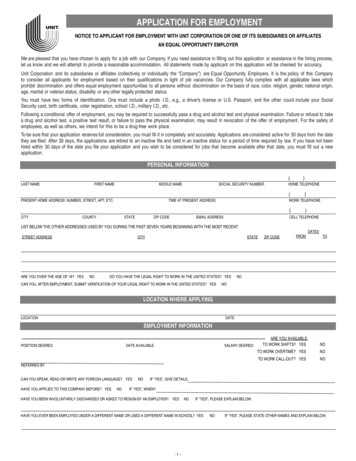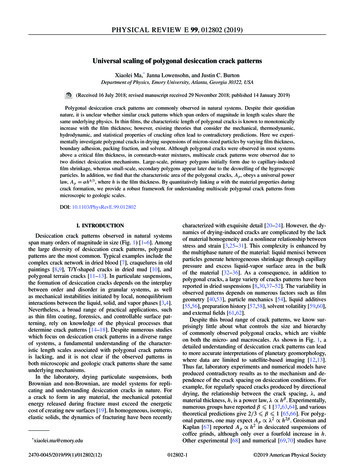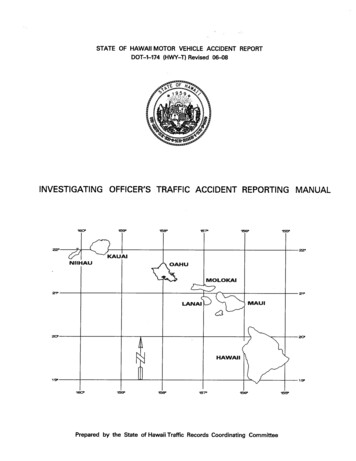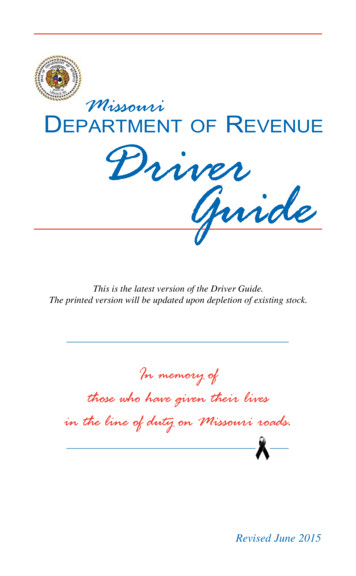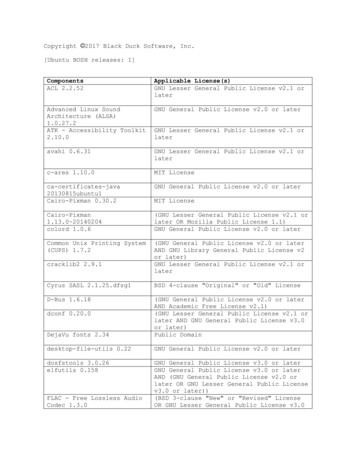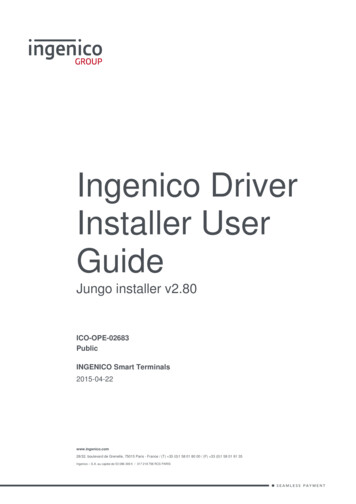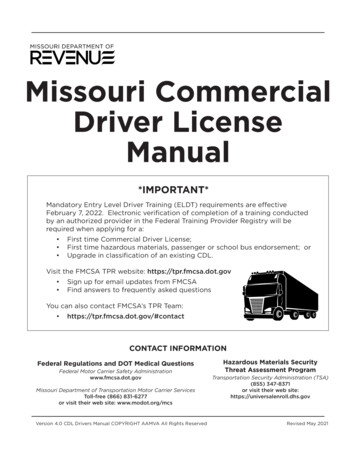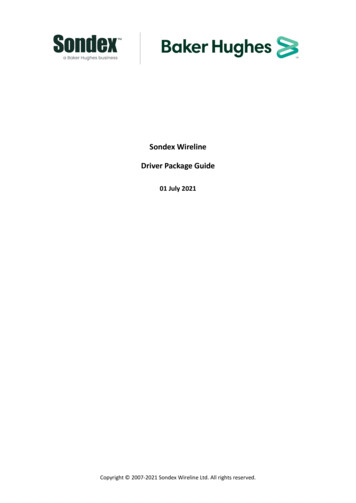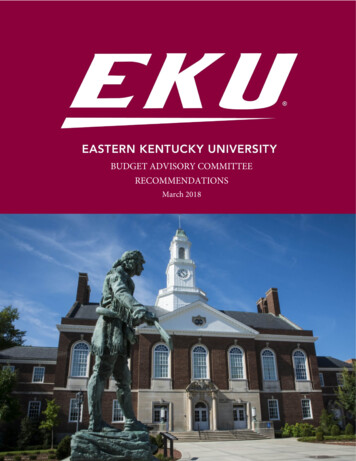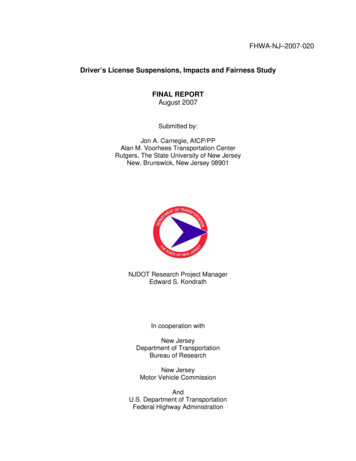
Transcription
FHWA-NJ–2007-020Driver’s License Suspensions, Impacts and Fairness StudyFINAL REPORTAugust 2007Submitted by:Jon A. Carnegie, AICP/PPAlan M. Voorhees Transportation CenterRutgers, The State University of New JerseyNew, Brunswick, New Jersey 08901NJDOT Research Project ManagerEdward S. KondrathIn cooperation withNew JerseyDepartment of TransportationBureau of ResearchNew JerseyMotor Vehicle CommissionAndU.S. Department of TransportationFederal Highway Administration
This page intentionally left blank.
DISCLAIMER STATEMENTThe contents of this report reflect the views of the authors who are responsible for thefacts and the accuracy of the data presented herein. The contents do not necessarilyreflect the official views or policies of the New Jersey Department of Transportation, theNew Jersey Motor Vehicle Commission or the Federal Highway Administration. Thisreport does not constitute a standard, specification, or regulation.
This page intentionally left blank.
TECHNICAL REPORT STANDARD TITLE PAGE1. Report No.2.Government Accession No.3. Recipient’s Catalog No.FHWA NJ-2007-0204. Title and Subtitle5. Report DateDriver’s License Suspensions, Impacts and Fairness StudyAugust 20076. Performing Organization Code7. Author(s)8. Performing Organization Report No.Carnegie, Jon A.9. Performing Organization Name and Address10. Work Unit No.Alan M. Voorhees Transportation CenterRutgers, The State University of New Jersey33 Livingston AvenueNew Brunswick, NJ 0890111. Contract or Grant No.12. Sponsoring Agency Name and Address13. Type of Report and Period CoveredNew Jersey Department of TransportationPO 600Trenton, NJ 08625Federal Highway AdministrationU.S. Department of TransportationWashington, D.C.14. Sponsoring Agency Code15. Supplementary Notes16. AbstractIn New Jersey, as is the case in many other jurisdictions, the reasons for driver’s license suspension are diverse,complex and sometimes interrelated. License suspension in New Jersey is no longer only used to punish habitual baddriving. It is widely used as a punishment or deterrent for things completely unrelated to driving and as a means tocompel appearance in court and/or payment of various fines, fees, and other financial obligations. Suspension patternsindicate that certain segments of the licensed driver population are more likely to be suspended than others. For allreasons, except suspensions for DUI and accumulation of motor vehicle points, drivers residing in urban and lowerincome zip codes are overrepresented. Suspension rates among male drivers residing in lower income areas areconsistently the highest.The obvious and most direct impact of license suspension is loss of personal mobility. However, suspension may alsohave collateral and/or unintended consequences such as job loss, difficulty in finding employment, and reducedincome. Consequences can also include other financial impacts, such as increased insurance premiums and othercosts associated with suspension; as well as psychological and social impacts such as loss of freedom, increasedstress, and family strain. Despite a limited menu of options to address the unintended or collateral impacts ofsuspension, there appear to be areas of possible reform in New Jersey. These include: reexamining the purpose andneed for the NJ insurance surcharge program; assessing the fairness of the Parking Offenses Adjudication Act;addressing issues that contribute to license suspensions for failing to maintain proper insurance; and considering thecreation of a restricted-use license program for at least certain suspended drivers under limited circumstances.17. Key Words18. Distribution StatementDriver license suspension, Impacts of license suspension,Restricted-use license19. Security Classif (of this report)20. Security Classif. (of this page)UnclassifiedUnclassifiedForm DOT F 1700.7 (8-69)21. No of Pages22. Price
This page intentionally left blank.
ACKNOWLEDGMENTSThe author wishes to thank the following individuals without whom this studywould not have been possible:Members of the Voorhees Transportation Center’s Research TeamDr. Richard Brail, Research AdvisorJianye Chen, Graduate Research AssistantDr. G. Lawrence Farmer, Research AdvisorAaron Kardon, Graduate Research AssistantAndrea Lubin, Project ManagerKhabirah Myers, Legal Research AssistantJeffrey Perlman, Graduate Research AssistantYustina, Saleh, Graduate Research AssistantMembers of the Research Selection and Implementation PanelDonald Borowski, NJMVCCarol Hollows, NJMVCEdward Kondrath, NJDOTHoward Pollak, NJMVCRobert Sasor, NJDOTStaff from the New Jersey Motor Vehicle CommissionGordon Deal, NJMVCTom Flynn, NJMVCLee Jackson, NJMVCNancy King, NJMVCSandra McCoy, NJMVCJeffrey Pistol, NJMVCii
This page left intentionally blank.iii
TABLE OF CONTENTSExecutive Summary . 1Introduction . 8Background and Problem Statement . 8Research Objectives and Approach. 8Report Outline. 10Literature Review . 11Introduction . 11Definitions . 11License Suspension as a Means of Altering Undesirable Behavior . 12Economic and Social Effects of Driver’s License Suspension. 17Summary. 21Driver’s License Suspension in New Jersey. 22Overview of New Jersey Suspension Statistics. 22Characteristics of Suspended Drivers in New Jersey. 23Age and Gender Profile of Suspended Drivers . 27Incidence of Multiple Suspensions and Suspended Drivers with Points . 28Geographic Profile of Suspended Drivers in New Jersey. 29Reasons for Suspension . 32New Jersey Point System. 34Operating a vehicle under the influence of drugs or alcohol . 38Driving while suspended or revoked. 39Insurance Surcharge Program. 41Parking Offenses Adjudication Act . 44Failure to comply with a child support order . 46Failure to maintain insurance. 47Comprehensive Drug Reform Act. 49Failure to appear in court. 51Failure to comply with a court ordered installment plan. 53Suspended Driver Survey . 55Survey Methods . 55Survey Findings . 55State Motor Vehicle Agency Outreach . 60Summary Discussion and Conclusions . 65Works Cited . 70iv
LIST OF TABLESTable ES1: Suspension rates by area type and income class (May 2004).5Table 1: Number of suspensions ordered or confirmed by MVC annually.23Table 2: Number of suspended drivers by gender and age group (May 2004) .27Table 3: Suspension rates in other states .28Table 4: Incidence of multiple suspensions among suspended drivers (May 2004). 29Table 5: Point accumulation by suspended drivers (May 2004) .29Table 6: Distribution of NJ licensed drivers by area type and income class (May 2004) .30Table 7: Distribution of suspended drivers by area type and income class (May 2004) .30Table 8: Suspension rates by area type and income class (May 2004) .32Table 9: Average number of suspensions ordered/confirmed by MVC annually – Top twelve“reasons” .33Table 10: Non-point violation events recorded annually by MVC .34Table 11: New Jersey point schedule .35Table 12: Suspension rates by area type and income – Point accumulation and other drivingrelated reasons, excluding DUI (May 2004) .37Table 13: Suspension rates by area type and income – Operating a motor vehicle under theinfluence of alcohol or drugs (DUI) (May 2004) .39Table 14: Suspension rates by area type and income – Driving while suspended or revoked (May2004) .40Table 15: Schedule of fines and penalties for driving while suspended/revoked.41Table 16: Offenses subject to insurance surcharge .42Table 17: Suspension rates by area type and income – Non payment of MVC insurancesurcharges (May 2004) . 43Table 18: Suspension rates by area type and income – Parking Offenses Adjudication Act (POAA)(May 2004) .45Table 19: Suspension rates by area type and income – Failure to comply with a child support order(May 2004).47Table 20: Suspension rates by area type and income – Failure to maintain proper insurance (May2004) .49Table 21: Suspension rates by area type and income – Drug offenses under the ComprehensiveDrug Reform Act (May 2004) .50Table 22: Suspension rates by area type and income – Failure to appear in court to answer asummons for a motor vehicle moving violation (May 2004) .52v
Table 23: Suspension rates by area type and income – Failure to appear in court to answer asummons issued for other non-driving reasons, excluding POAA (May 2004).53Table 24: Suspension rates by area type and income – Failure to comply with a court orderedinstallment payment plan (May 2004) .54Table 25: Economic impacts of license suspension across income groups. .57Table 26: Economic impacts of license suspension across age groups.57Table 27: Summary of restricted use license programs .63-64LIST OF FIGURESFigure ES1: Proportion of suspended drivers by reason and area type – Income (2004) .4Figure ES2: Proportion of suspended drivers by reason and area type – Population density (2004).5Figure 1: Ten year history of suspensions ordered or confirmed by MVC.23Figure 2: New Jersey Population Density (2000) .25Figure 3: New Jersey Median Household Income (2000).26Figure 4: Proportion of suspended drivers by reason and area type – Income (2004).31Figure 5: Proportion of suspended drivers by reason and area type – Population density (2004) .31Figure 6: Parking tickets pending over 60 days.44Volume 2: Technical Appendices:Appendix A: State Agency Outreach – Summary Report, Individual State InterviewReportsAppendix B: Suspended Driver Survey QuestionnaireNOTE: Volume 2 is available upon request as a separate document only.vi
This page intentionally left blank.vii
EXECUTIVE SUMMARYIntroduction and BackgroundAt any given time, approximately 300,000 (less than 5 percent) of the licensed drivers inNew Jersey have their driving privileges suspended. Suspensions occur for a variety ofreasons, both driving and non-driving related. Some estimates indicate that fifty percentof people with suspended driver’s licenses had their licenses suspended for reasonsother than how safely they operate a vehicle. In addition, there is the perception thatthere has been a marked increase in suspensions, primarily for failing to pay fees, fines,surcharges, or other financial obligations rather than safe driving issues. Furthermorethere is some evidence that it is more difficult for poorer drivers to pay the debt theyowe to recover their driver’s licenses. If the debt is not paid on time, additional interestand penalties accrue, resulting in a decreased likelihood that the debt will ever be paidand that the individual will regain their driver’s license. There is a belief that this cyclemay push poorer individuals out of jobs because many jobs are only accessible bypersonal automobile. Research is needed to analyze and assess patterns of licensesuspension in New Jersey and to investigate the impacts and fairness of New Jersey’sdriver’s license suspension program.Research Objectives and ApproachThe objectives of the study were to:1. Document the extent and nature of driver’s license suspension in New Jersey;2. Determine the motor safety, financial, socio-economic, geographic and insuranceimpacts of license suspension; and3. Examine methods for reducing or eliminating negative or unintended impacts ofdriver’s license suspension.The research program undertaken to achieve these objectives included a review ofnational literature, key informant interviews, an analysis of driver history data providedby the NJ Motor Vehicle Commission, a survey of state agency suspension practices,an inventory of restricted-use license programs used in other states, and a survey ofsuspended drivers in New Jersey.Key FindingsNew Jersey has approximately six million licensed drivers. The vast majority of thesedrivers remain violation and suspension free throughout their driving years. Only asmall percentage of drivers (five percent) have their driving privileges suspended or1
revoked at any given time. Forty three percent of New Jersey drivers reside in urbanareas, while 38 percent live in suburban areas and 19 percent live in rural parts of theState. Most New Jersey drivers live in middle income areas. Only about 17 percent ofall licensed drivers in the state live in lower income zip codes and 12 percent live in highincome areas.It does not appear that there has been an upward trend in the number of licensesuspensions being ordered or confirmed by the MVC. An analysis of time series dataindicates that over the past ten years the number of suspensions has fluctuated but hasremained relatively constant at approximately 800,000 /- per year. This figurerepresents the total of individual suspension actions taken, not the number of driverssubject to those actions. For example, it is common for an individual driver to haveseveral active suspension orders on his/her record at a given time. So, the number ofsuspended drivers at any given time is far less than the number of suspensions orderedor confirmed each year.Driver’s license suspension was originally conceived as a sanction used to punish “baddrivers.” The logical nexus between driving behavior and sanction was clear. However,today in New Jersey, license suspensions are not imposed to punish habitual baddriving. The reasons for driver’s license suspension are diverse, complex andsometimes interrelated. Reasons include those that are clearly driving related (e.g.,DUI, point accumulation, reckless driving, and driving while suspended); those that areclearly not driving related (e.g., compliance reasons such as failure to pay child supportor failure to appear in court for a non-driving offense and suspensions imposed for drugrelated offenses not involving the operation of a motor vehicle); and those that are forcompliance reasons indirectly related to driving behavior or motor vehicle use. Theseinclude: failing to appear in court to pay/satisfy a parking ticket or moving violation;failing to maintain proper auto insurance; and failing to pay MVC insurance surchargesthat stem from a driving related infraction.Most suspended drivers (64 percent) have more than one active suspension. Less thansix percent of all suspended drivers are suspended for purely driving-related reasons.The vast majority of drivers are suspended not for habitual “bad driving,” but for avariety of compliance reasons stemming from one or more motor vehicle infraction,parking tickets, or failing to maintain proper insurance. Only a small percentage ofdrivers, less than five percent, are suspended for purely non-driving, non-motor vehiclerelated reasons. It is noteworthy that most suspended drivers (59 percent) have zeromotor vehicle violation points. However, it should also be noted that some seriousdriving offenses, such as DUI and driving while suspended do not result in theassessment of motor vehicle points. Instead, in most cases, these violations carrysubstantial fines and mandatory suspension periods.A detailed analysis of suspension statistics and survey data specific to New Jerseyindicates that suspended drivers tend to be younger male drivers. Furthermore, a2
disproportionate number of suspended drivers reside in urban and low-income areaswhen compared to the distribution of all New Jersey licensed drivers. Although only 43percent of New Jersey licensed drivers reside in urban areas, 63 percent of suspendeddrivers live there. At the same time only 16.5 percent of New Jersey licensed driversreside in lower income zip codes, while 43 percent of all suspended drivers live there.This may be due to a variety of reasons. For example, most parking infractions occur inurban areas because urban areas have more parking restrictions than suburban andrural areas. As such, urban residents have a greater chance of violating parking laws.Similarly, the street and highway network in urban areas is more dense, with higherlevels of traffic, more intersections, stop signs, traffic lights, and slow speed zones thansuburban and rural areas. Generally, there is also a greater law enforcement presencein urban communities. Consequently, there are more opportunities to violate traffic lawsand urban residents may be at greater risk of being observed violating traffic laws.Finally and perhaps most importantly, low income residents are more concentrated inthe state’s urban areas. This population may be less able to pay fines, fees andsurcharges given their more limited financial resources.The obvious and most direct impact of license suspension is loss of personal mobility.However, suspension may also have collateral and/or unintended consequences suchas job loss, difficulty in finding employment, and reduced income. Consequences canalso include other financial impacts, such as increased insurance premiums and othercosts associated with suspension; as well as psychological and social impacts such asloss of freedom, increased stress, and family strain. In addition, suspension can alsohave broader economic and societal impacts such as limiting the labor force for specificindustries such as automobile sales and services, home health care aides and theconstruction trades. Jobs in each of these industries depend on semi-skilled workerswith a valid driver’s license. In addition, many employers use possession of a validdriver’s license as a pre-qualifying “screening” question. This may unnecessarily limitthe available labor force when driving a motor vehicle is not integral to jobresponsibilities.Although not available in New Jersey, conditional or restricted-use driver’s licenses areavailable in 39 states and the District of Colombia. These licenses allow some or allsuspended/revoked drivers to receive limited driving privileges during the time they aresuspended. Program eligibility varies widely from state to state. Some states offerrestricted-use licenses to drivers suspended for compliance reasons, but most stateslimit the use of restricted-use licenses to drivers with time delimited suspensions, suchas those imposed for a first time DUI offense, for point accumulation and for other trafficviolations after a specified minimum period of suspension is served. Most often, thewaiting period ranges from 30 to 90 days, although a few states require all conditionallicense applicants to serve half of their suspension/revocation period prior to beingconsidered eligible for the license.3
In most states, conditional or restricted-use licenses are not available to driverssuspended/revoked for multiple DUI offenses, negligent vehicular homicide, or habitualoffenders. Furthermore, in most states, drivers suspended for compliance reasons arenot eligible. Permitted travel and associated restrictions related to conditional uselicenses also vary by state. Penalties for violating program restrictions most typicallyinvolve the cancellation of the restricted-use license and reinstatement of the originalsuspension or revocation. Some states also extend the original suspension/revocationperiod, between several months to double the original period.Conclusions and RecommendationsIt is clear from this study that license suspension in New Jersey is widely used as apunishment, a deterrent and as a means to compel appearance in court and/or paymentof various fines, fees, and other financial obligations. It also appears that in somecircumstances, license suspension or the threat of suspension can be effective inachieving these purposes. For example, the Parking Offenses Adjudication Act (POAA)which allows license suspension when a driver fails to appear in court to satisfy aparking summons has been very effective in reducing the number of outstandingparking tickets pending over 60 days. In 1990, there were almost 4.4 million parkingtickets that remained unpaid longer than two months. That number droppedprecipitously through the 1990’s after the law took effect and as more municipal courtsystems became automated. In 2004, the number of parking tickets pending over 60days was less than vingnFTA-Nondrpl asayrt pouaycnpNonpayInssurchaenrgedepospsuil ewhNoDri vingnpNodrtr isdsupmotoedurUnaychilRAtLower Incomeinsses-vi ofe dle IncomeHigh IncomeFigure ES1. Proportion of suspended drivers to licensed drivers by reason and areatype – Income (May 2004)4
2.502.001.501.000.50IDUintsPoendedsNour cnphargayescour tpaypFTl anA-Nond riv ingInsNonpayhilesuspsuppildchngwDrivinpayNoUrbano rtistAmot orDRed-CurinsUnOff eningDrug-Movsesat ioningviola rk-PFTAFTAAllReasons-SuburbanRuralFigure ES2. Proportion of suspended drivers to licensed drivers by reason and areatype – Population Density (May 2004)Suspension patterns indicate that certain segments of the licensed driver population aremore likely to be suspended than others. For all reasons, except suspensions for DUIand accumulation of motor vehicle points, drivers residing in urban and lower incomezip codes are overrepresented (see figures 1 & 2). Suspension rates among maledrivers residing in lower income areas are consistently the highest (see table 1).Table ES1 - Suspension rates by area type and income class (May 2004)Male7%StatewideBy Population Density 2Urban ( 800 p/sq mi)Suburban (200-800 p/sq mi)Rural ( 200 p/sq mi)Unknown *By HH Income Class3High ( 85,000)Middle High ( 65,001 - 85,000)Middle ( 40,001 - 65,000)Low ( 20,000 - 40,000)Low-Low( 20,000)Suspension Rates %3%7%14%1%2%4%12%24%Notes: 1 – Suspension rates were calculated by dividing the number of suspended drivers by the number of licenseddrivers in each zip code. The rates reported in this table represent the ratio of suspended drivers to licensed drivers;2- density calculation based on zip code data from 2000 US Census;3 - income classifications based on zip code data from 2000 US Census;Special Note: 1,788 records could not be matched to zip code reference file5
Although the impacts of license suspension may vary by individual driver, the socialimplications of New Jersey suspension patterns should be of concern. Low-incomeurban residents face many challenges, not the least of which is obtaining and retaininga job and meeting basic family financial needs. Given the decentralization ofemployment opportunities over the past forty years in the state, the only viable means oftransportation to work for many may be by private automobile. Having their drivingprivileges suspended can be a significant additional impediment to gainful employment.Unfortunately, programs and interventions used in other states to address the potentialcollateral impacts of license suspension (especially economic impacts related to loss ofemployment) appear mostly limited to flexible fine/fee payment options, paymentamnesty programs and the use of restricted-use licenses. Despite this limited menu ofoptions, there appear to be areas of possible reform in New Jersey.First, the New Jersey legislature should reexamine the purpose and need for the MVCinsurance surcharge program. In 1983, the legislature enacted the New Jersey MeritRating Plan (N.J.S.A. 17:29 A-35), which required MVC to assess “insurance”surcharges based on certain motor vehicle offenses. When enacted in 1983, theoriginal purpose of the NJ Merit Rating Plan insurance surcharges was to providerevenue for the New Jersey Automobile Full Insurance Underwriting Association (a.k.a.- Joint Underwriters Association or JUA) to fund medical expenses from uninsuredmotorists. The original bonds issued to support the JUA have since been retired andthe revenue stream has been earmarked to pay down other state debt.New Jersey is one of only four states in the Nation with such a surcharge program. Theother states include New York, Texas, and Michigan. Almost one-third of all suspensionordered annually by MVC (28 percent or 228,000 orders) are for failure to pay insurancesurcharges. Given the volume of suspensions for this reason and the fact that thegreatest burden of surcharge suspensions fall on low-income drivers – almost 40percent of drivers suspended for failure to pay insurance surcharges reside in lowincome zip codes, it appropriate to weigh the proportionally high impact of surchargesuspensions on low-income drivers against the benefit of the program. Currently, theonly public purpose
driver's license suspension program. Research Objectives and Approach The objectives of the study were to: 1. Document the extent and nature of driver's license suspension in New Jersey; 2. Determine the motor safety, financial, socio-economic, geographic and insurance impacts of license suspension; and 3.
